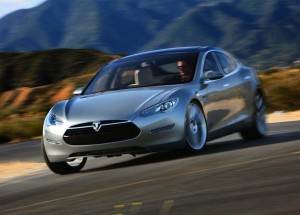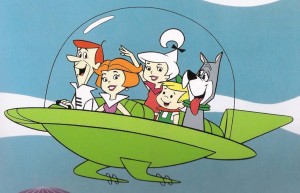
Battery cars like the Tesla Model S will soon have to emit noise to warn pedestrians and bicyclists.
Hit the Start button in the new Ford Focus Electric and you might think nothing has happened – not unless you notice the flash of lights and gauges on the instrument panel. For many buyers, one of the big benefits is the way battery-based vehicles can operate almost silently.
But there are also a number of critics, notably including the National Highway Traffic Safety Administration, who believe there’s a downside to electric propulsion, especially when operating in a crowded urban environment where pedestrians may not here the vehicle coming.
Now, NHTSA is calling on carmakers to amp up the noise level. The federal safety agency has proposed a new rule that would require such vehicles operating at speeds under 18 miles per hour make enough noise to be heard by pedestrians, especially those with impaired vision, over the normal din of a city street.
The Pedestrian Safety Enhancement Act, originally approved by Congress two years ago, will be phased in between now and the 2016 model-year. While setting a minimum noise level, NHTSA has decided to give manufacturers a wide berth to come up with customized sounds that they feel might best fit their particular brand and product.
“Our proposal would allow manufacturers the flexibility to design different sounds for different makes and models while still providing an opportunity for pedestrians, bicyclists and the visually impaired to detect and recognize a vehicle and make a decision about whether it is safe to cross the street,” explained NHTSA Administrator David Strickland.
The announcement of the new rules comes at a time when there are disturbing signs that collisions involving pedestrians are on the rise again after years of decline. Last August, NHTSA reported pedestrian fatalities in 2010 – the latest year for which full data had been analyzed – rose 4% to 4,280, with another 70,000 Americans injured. That accounted for 13% of all traffic fatalities compared with 11% between 2002 and 2007.
While battery-based vehicles still account for a miniscule fraction of the American motor vehicle fleet, there is concern that as the number of hybrids, plug-ins and electric vehicles grow the situation could worsen without a solution to warn off pedestrians. NHTSA analysts estimate a hybrid vehicle is 19% more likely to be involved in a pedestrian crash than a vehicle powered by a conventional, internal combustion engine. And there’s a 38% increase involving collisions with bicycles.
The proposal is expected to add about $35 to the cost of a typical battery-based vehicle – or $23 million annually. Nonetheless, it has win initial praise from the Alliance of Automobile Manufacturers, especially for its flexibility.
“The alliance will continue working with National Federation of the Blind, and others,” said a spokesman, “to work toward this being the model for an international safety standard. In the coming weeks we’ll review the proposal’s technical elements to help ensure that the safety standard meets the needs of the blind, and takes into appropriate consideration concerns about overall levels of ambient noise.”
NHTSA, which began studying the problem in 2007, is working with regulators in Europe and Japan towards the goal of setting a common, worldwide standard.
The agency believes the use of warning sounds could reduce the number of pedestrian and bicycle collisions by about 2,800 annually.
A three-year phase-in could begin as early as September 2015 with the start of the 2016 model-year.
Some battery vehicles, such as the Nissan Leaf, already emit warning sounds when operating in reverse, some also allowing motorists to switch warning sounds on during regular urban driving.
Precisely what sort of sounds makers might choose remains to be seen. They could range from the beeping noise made by trucks backing up to the simulated sound of a conventional gas-powered vehicle. Several years ago, European tuner company Brabus demonstrated several possible options on a Smart fortwo Electric Drive. In one mode, the minicar sounded like it had a V-8 engine, hidden speakers roaring when the driver stomped on the accelerator. Another alternative sounded like the warbling of the flying car driven by the space age family in the TV cartoon series The Jetsons.


While I agree some sort of noise device is probably useful, is the increase in pedestrian accidents a result of pedestrians not seeing/hearing the vehicles or distracted drivers not watching where they are driving nor seeing pedestrians that could walk out in front of their vehicle just like they do any other auto?
The data appear to suggest that in crowded environments, especially parking lots, the inability to hear a vehicle complicates the situation and raises the number of pedestrian collisions. There’s a direct correlation between EVs and higher collisions that suggests it’s the pedestrian being caught unaware.
Paul A. Eisenstein
Publisher, TheDetroitBureau.com